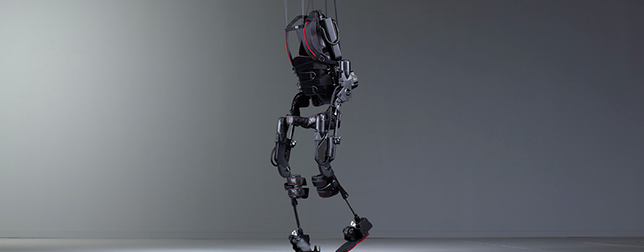Powered exoskeletons are wearable mechanical devices that are powered by a system of electric motors, levers, pneumatics, hydraulics, or a combination of technologies that enables limb to move with increased strength and endurance. These devices made of rigid or soft materials are worn by people whose construction mirrors the structure of their limbs, joints, and muscles and works in tandem with them.
In the past, exoskeletons were designed by defense departments for military applications. After that, these devices were commercially produced for medical rehabilitation (often for wounded veterans), or as mobility aids allowing paraplegics to stand upright, walk and climb stairs.
The New Generation Exoskeletons
The new generation of commercial exoskeletons have been helped by more efficient battery solutions, while others resorted to non-traditional power solutions such as compressed air. Examples of commercial class powered exoskeletons are: Innophys’ Muscle Suit, Activelink’s Powerloader Ninja, Cyberdyne’s HAL for Labor Support RB3D’s HERCULE, Esko Bionics’ Esko Vest, Sarcos Robotics’ Guardian XO and Noonee’s Chairless Chair.
Read more Designing Exoskeletons to Interact with Humans
As opposed to powered exoskeletons, unpowered exoskeletons employ a combination of human guided flexion/extension and locking mechanisms to increase strength and stability. Unpowered exoskeletons for commercial and industrial use includes suitX’s MAX Exoskeleton Suite, Ekso Bionics’ Work Vest, StrongArm Technologies’ FLx ErgoSkeleton, Laevo’s Laevo and Lockheed Martin’s Fortis.

Rigid vs. Soft Exoskeletons
Rigid exoskeletons are heavy and therefore can put too much pressure on the musculoskeletal system. As a result various companies are now trying to develop new types of exoskeletons called soft exos. These soft exoskeletons are made of lightweight and soft materials. The systems are powered by compressed air or soft muscle actuators, or by using flexion/extension mechanisms.
Read more Myosuit: Wearable Device that Helps Myopathy or Stroke Patients Walk
A team of scientists at the Wyss Institute for Biologically Inspired Engineering and the Harvard John A. Paulson School of Engineering and Applied Sciences (SEAS) ran study to see how machine learning can personalize soft exoskeleton controls. The team used a technique called “human-in-the-loop optimization.” The technique utilizes real-time measurements of human physiological signals, such as breathing rate, to adjust the control parameters. As the algorithm focused on the best parameters, it directed the exosuit on when and where to deliver assistive force.
More to Come
New exoskeletons, backed by advanced materials, battery and actuator, will continue to arrive at the market. The number of industries employing these technologies such as, construction and agriculture, will increase. This will happen due to the obvious reason, that the use of exoskeletons will help businesses increase productivity, reduce worker injury and generate more profit.












